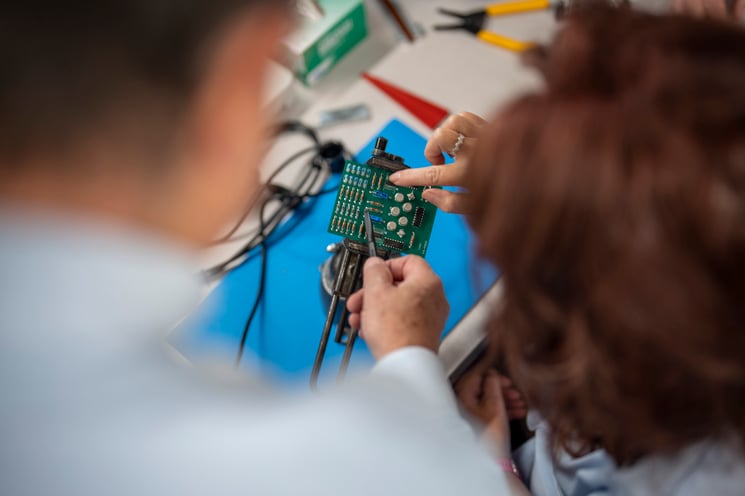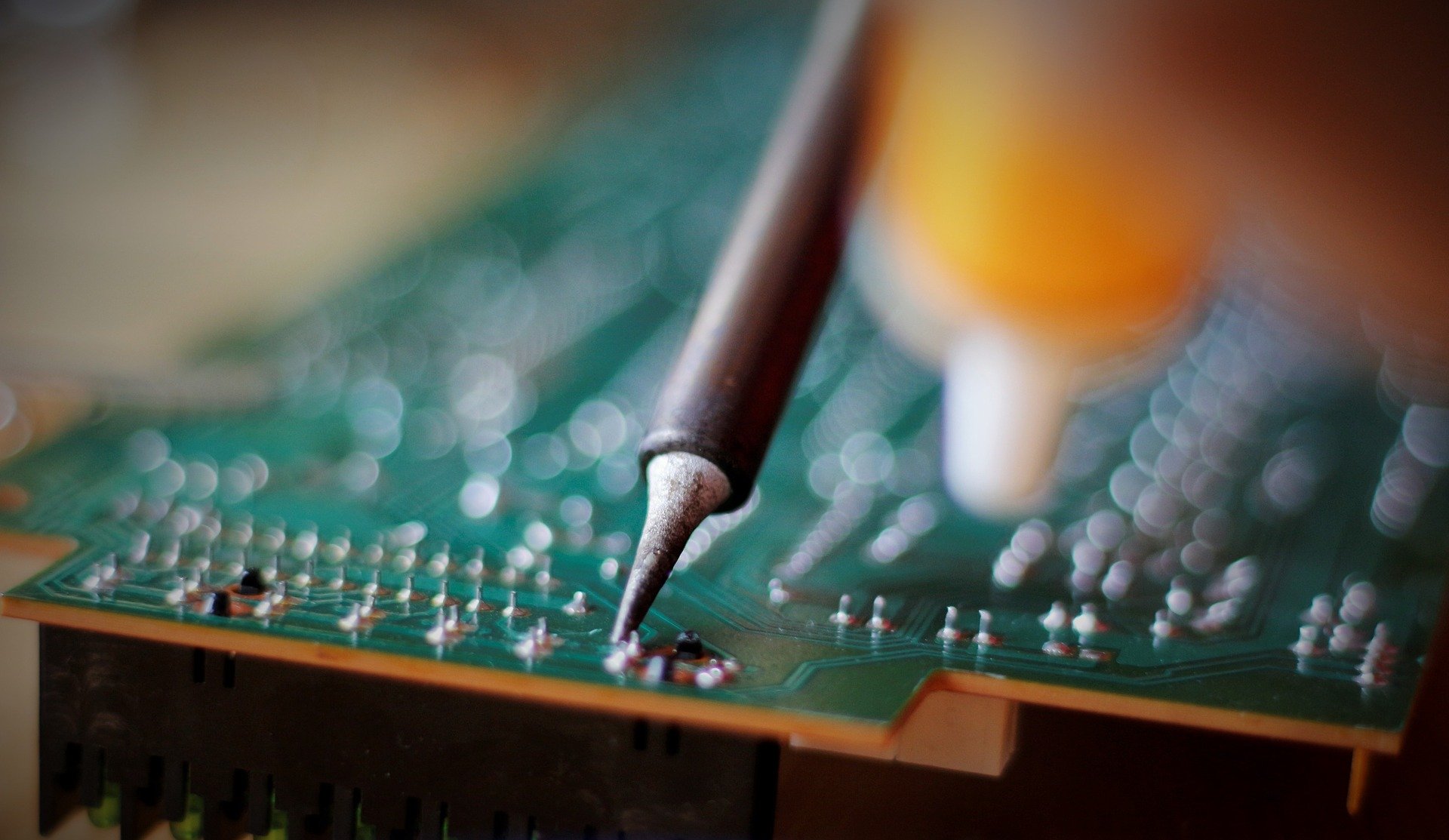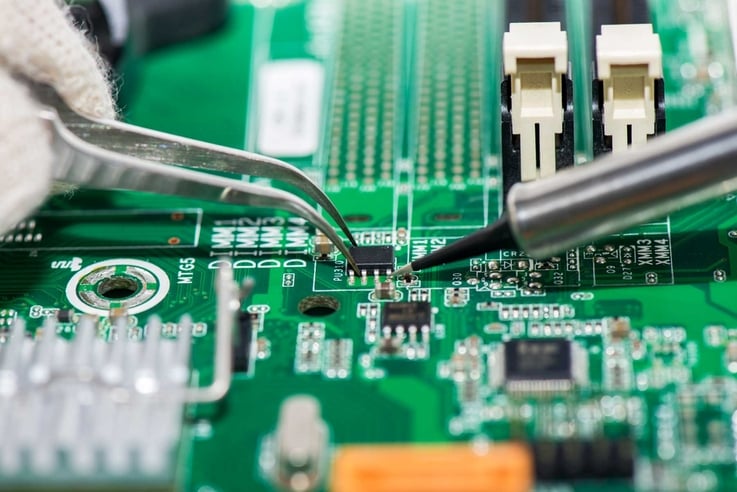Welcome to our new blog series, "The Soldering Spotlight: Inspiring Stories of Craftsmanship". In this series, we are exploring the world of soldering, featuring stories from individuals who have trained with EPTAC and earned IPC certification in soldering.
In our first interview, we have the privilege of introducing a talented assembler and quality inspector Barbara Whitaker from Leonardo DRS. Barbara’s journey started in a stockroom in Long Island, New York, and has taken her to an instrumental role at a manufacturing company in Florida. Her story is a testament to continuous learning and the transformative power of training. Through her journey, you will get to see how EPTAC’s training and IPC certification have been vital tools in Barbara’s skill set, influencing her career and helping her bring innovative solutions to her work. So, sit back and enjoy this captivating narrative that spans across the broad and ever-evolving spectrum of soldering craftsmanship.
Can you share your journey of becoming a skilled assembler/quality inspector and what sparked your interest in this field?
At the age of 18, I started working in a stockroom for a large military electronics manufacturing company in Long Island, New York after my sister, who worked in Procurement, suggested it. Kitting parts was boring, but I was curious what these parts did and how they came together to form something functional.
Upon relocating to Florida, a rare opportunity presented itself. I was able to attend the local community college for free at night to learn electronics assembly and soldering to MIL-STD-2000, with the potential for a new job at the end if I performed well. It turned out to be a great match for me, and I spent about 13 years at that company, learning various aspects of manufacturing, first as the Lead of the Solder and Rework Area and then as a Technical Trainer.
This period coincided with the release of IPC standards. I was excited that these “new” standards were much more concise in defining requirements and included more pictures and definitions than the previous military standards. Also, I was thrilled that the industry recognized the need to standardize training. Gone was the idea of each trainer training their version of MIL-STD-2000 and 2000A.
Around that time, electronics were undergoing significant changes with the advent of surface mount technology becoming more common. I decided it was time for a change and relocated to South Florida, where an opportunity to learn fiber optic assembly, and potentially a new job, presented itself. It was a good fit, but after a short time with the company, the skillset they needed most was my ability to do rework on CCAs, and eventually, the promise of IPC training and certification. Things looked promising until 9/11 happened. The company I worked for chose to close their facility, prompting the need for another relocation.
This time, I chose a location where there was plenty of electronics manufacturing happening and relocation would not be necessary. Space Coast of Florida- here I come! I was fortunate to work for a small Class 3 Contract Manufacturing company for about 20 years, where I was hired as a Technical Trainer. Anyone who has worked for a small company knows you never do one job. Working for a small company requires flexibility, the ability to wear multiple hats, and it provides a lot of learning opportunities.

During my 20 years there, the industry was changing. Surface mount components were becoming smaller and more complex, and designs were becoming more demanding. The knowledge I obtained from certification and the experience I gained allowed me to successfully train, perform complex solder, rework, modification, and repair tasks. This experience has made me a valuable asset and enabled me to move on to another exciting opportunity for growth.
Rework has always been satisfying for me because it requires problem-solving. What tool and method will give me the quickest, most accurate result with no damage? Tool choices alone can be overwhelming for some. Do I need bottom side heat, topside hot air, hot tweezers, desoldering gun, or a combination? What method should I use? If done correctly, it could potentially save the company money on scraped products.
For me, training provides the most satisfaction. It’s very rewarding when you see someone’s skill or knowledge improve because of the training you provide. The appreciation you receive from others when you offer extra patience and guidance when needed is truly gratifying.
This time, I chose a location where there was plenty of electronics manufacturing happening and relocation would not be necessary. Space Coast of Florida- here I come! I was fortunate to work for a small Class 3 Contract Manufacturing company for about 20 years, where I was hired as a Technical Trainer. Anyone who has worked for a small company knows you never do one job. Working for a small company requires flexibility, the ability to wear multiple hats, and it provides a lot of learning opportunities.
During my 20 years there, the industry was changing. Surface mount components were becoming smaller and more complex, and designs were becoming more demanding. The knowledge I obtained from certification and the experience I gained allowed me to successfully train, perform complex solder, rework, modification, and repair tasks. This experience has made me a valuable asset and enabled me to move on to another exciting opportunity for growth.
Rework has always been satisfying for me because it requires problem-solving. What tool and method will give me the quickest, most accurate result with no damage? Tool choices alone can be overwhelming for some. Do I need bottom side heat, topside hot air, hot tweezers, desoldering gun, or a combination? What method should I use? If done correctly, it could potentially save the company money on scraped products.
For me, training provides the most satisfaction. It’s very rewarding when you see someone’s skill or knowledge improve because of the training you provide. The appreciation you receive from others when you offer extra patience and guidance when needed is truly gratifying.
For me, training provides the most satisfaction. It’s very rewarding when you see someone’s skill or knowledge improve because of the training you provide.
Are there any specific soldering projects or techniques that you haven't tried yet but would like to explore in the future?
I am interested in setting up profiles for component removal and replacement on rework stations and/or bottom side heaters. I’d like to see training created for this.
Are there any notable changes or advancements in soldering/assembly techniques or equipment that you've witnessed throughout your career?
One significant change I've observed is the use of a bottom-side heater to preheat a board before performing soldering or rework operations.
If you could give one piece of advice to aspiring soldering enthusiasts, what would it be?
My advice would be to learn as much as you can.
Can you share a piece of advice or a tip that has significantly improved your soldering skills?
Expanding my knowledge base has been invaluable. I’ve gained tremendous knowledge by reading other referenced standards outside of those with a certification, for example, IPC-HDBK-001, IPC-AJ-820. I find them to be a tremendous resource of information and often overlooked.
I’ve gained tremendous knowledge by reading other referenced standards outside of those with a certification, for example, IPC-HDBK-001, IPC-AJ-820. I find them to be a tremendous resource of information and often overlooked.
Can you describe a moment when you felt the most accomplished or proud of your soldering/assembly work?
One moment that stands out for me involves a new product design. Engineering needed a resistor soldered to each lead of a SOIC, with a jumper from the other end of each resistor going to another lead of the SOIC. There was almost no real estate on the board to place any resistors, and definitely not one for each lead. The board, roughly 4” by 4”, was densely populated surface mount on both sides. The solution was to lay each resistor on its long edge on each lead of the SOIC, with the other end of the resistor above the knee of the lead, and run a jumper from the end of the resistor to the new lead. Engineering had reservations about whether this could be accomplished. It was and it worked wonderfully, surprisingly, even looked good. Design engineering was ecstatic. Of course, this was for engineering purposes only.
Could you share your experience with the EPTAC training program and how it has impacted your soldering/assembly skills?
Over several years, I have frequently returned to EPTAC for a variety of certifications. Their satellite location is conveniently close, reducing expenses for the company as there's no need to travel.
Would you recommend EPTAC’s training or IPC certification courses to other aspiring solderers? What specific benefits or advantages did you gain from these courses?
The more you know the more tools you have in your toolbox.
How do you think EPTAC’s training or IPC certification courses have helped you stay up-to-date with industry standards and best practices in soldering?
IPC includes new information in each revision release, ensuring that you're up-to-date on newer technologies.
Did the EPTAC’s training or IPC certification courses provide you with practical hands-on training that was directly applicable to real-world soldering/assembly projects? If yes, can you provide an example of how this training benefited you in your work?
Probably, the most significant improvement was when I started using bottom-side preheaters along with top side heat in the form of an iron, desolder gun, or top side hot air. This method has significantly increased my success rates in soldering and reworking without causing any damage.
Have you noticed any significant improvements in your soldering abilities and confidence after completing the EPTAC training or IPC certification courses? How have these certifications impacted your career opportunities or professional growth?
After decades of certification and recertifications in IPC-A-600, IPC-A-610, IPC/WHMA-A-620, IPC J-STD-001 and IPC-7711/7721, I have the confidence to take on almost any project that requires manually solder, rework, and repair.
After decades of certification and recertifications in IPC-A-600, IPC-A-610, IPC/WHMA-A-620, IPC J-STD-001 and IPC-7711/7721, I have the confidence to take on almost any project that requires manually solder, rework, and repair.
__________________________________________________________________________________
EPTAC - An International Leader in Solder Training and IPC Certification
For over 35 years, EPTAC has been a leading provider of solder training and IPC certification. We provide professionals with the tools and training they need to advance their careers and improve their businesses. With 24 locations across North America, our solutions and instructional staff provide an easy access to knowledge that will enhance your business model and help you meet and exceed industry demands. For more information call 800.643.7822 or contact us.






